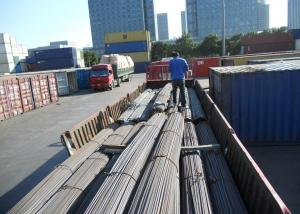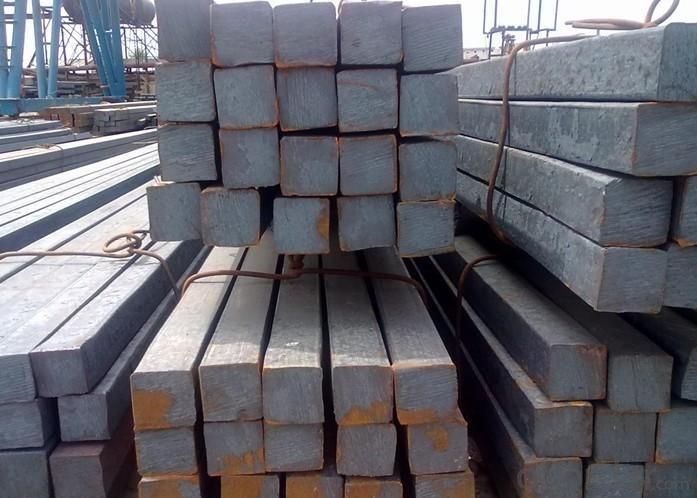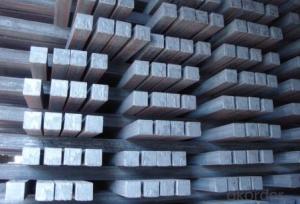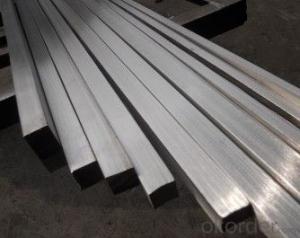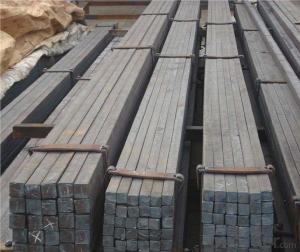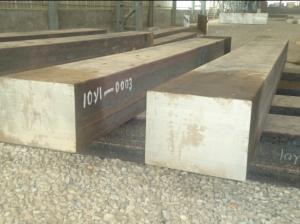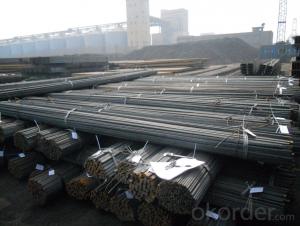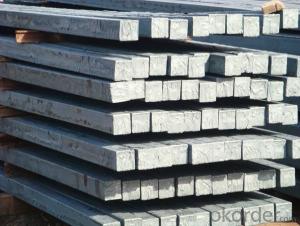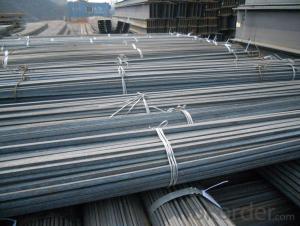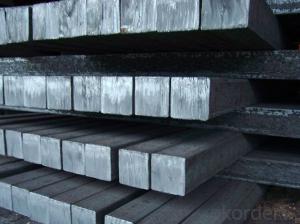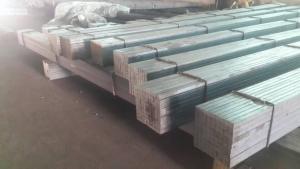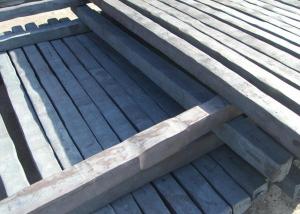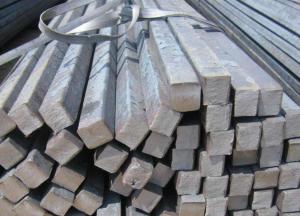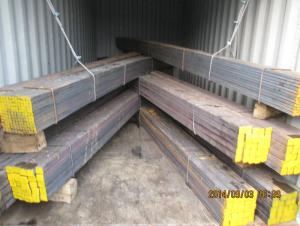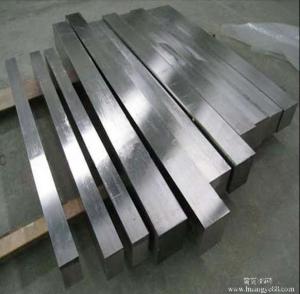Hot Rolled Square Bar
- Loading Port:
- Tianjin Port
- Payment Terms:
- TT or LC
- Min Order Qty:
- 50Tons m.t.
- Supply Capability:
- 500 tons per month m.t./month
OKorder Service Pledge
OKorder Financial Service
You Might Also Like
Specifications of Hot Rolled Square Bar:
-Standard: GB,
-Grade: Q235 or equivalent.
Chemical Composition:
|
Standard |
Grade |
Element (%) | ||||
|
GB |
Q235B |
C |
Mn |
S |
P |
Si |
|
0.12~0.20 |
0.30~0.70 |
≤0.045 |
≤0.045 |
≤0.30 | ||
Measures of Hot Rolled Square Bar:
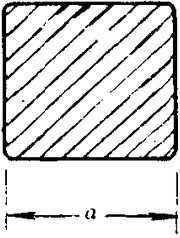
(Section of HR Square Bar)
-Length of a side and Theoretical weight of Square Bar.
|
Length of a side(mm) |
Theoretical weight(kg/m) |
Length of a side(mm) |
Theoretical weight(kg/m) |
|
6 |
0.283 |
32 |
8.04 |
|
7 |
0.385 |
*33 |
8.55 |
|
8 |
0.502 |
34 |
9.07 |
|
9 |
0.636 |
*35 |
9.62 |
|
10 |
0.785 |
36 |
10.17 |
|
11 |
0.950 |
38 |
11.24 |
|
12 |
1.13 |
40 |
12.56 |
|
13 |
1.33 |
42 |
13.85 |
|
14 |
1.54 |
45 |
15.90 |
|
15 |
1.77 |
48 |
18.09 |
|
16 |
2.01 |
50 |
19.63 |
|
17 |
2.27 |
53 |
22.05 |
|
18 |
2.54 |
*55 |
23.6 |
|
19 |
2.82 |
56 |
24.61 |
|
20 |
3.14 |
*58 |
26.4 |
|
21 |
3.46 |
60 |
28.26 |
|
22 |
3.80 |
63 |
31.16 |
|
*23 |
4.15 |
*65 |
33.17 |
|
24 |
4.52 |
*68 |
36.3 |
|
25 |
4.91 |
79 |
38.49 |
|
26 |
5.30 |
75 |
44.16 |
|
*27 |
5.72 |
80 |
50.24 |
|
28 |
6.15 |
85 |
56.72 |
|
*29 |
6.60 |
90 |
63.59 |
|
30 |
7.06 |
95 |
70.85 |
|
*31 |
7.54 |
100 |
78.50 |
Notes:
1, The theoretical weights in the list, base on the density of 7.85 g/cm3.
2, Formula for theoretical weight of Square bar: a(length of a side) * a * 0.00785
3, The numbers with *mean that they are not regular or we don’t offer them.
-Regular length of Square Bar:
|
Steel |
Length of a side (mm) |
Length of steel (m) |
|
Normal steel |
< 25 |
4~10 |
|
> 25 |
3~9 | |
|
Steel of high quality |
All measure |
2~6 |
|
Tool steel >75 |
1~6 |
Usage/Applications of Hot Rolled Square Bar:
-The Square Steel is normally used as structure steel.
-Row material for other structure steel like steel angles, channels, I-beams, H-beams, etc…
-Row material for steel pipes.
Packaging & Delivery of Hot Rolled Square Bar:
-Packing Detail: The products can be packed in bundles by steel wires.
-Marks:
1, Tag marks: the tag marks will be tied up to each bundle of the products. The information is usually including supplier’s logo and name, product name, made in China, products’ specifications, the painted color and other information requested by customers.
2, Color marks: we will paint both ends of the bundles of these products to make sure that they are more evident. It’s will be more convenient for the customers to distinguish them at the destination port.
-Delivery Detail: 30~45 working days after receive buyer’s T.T. or L/C.
Transportation:
-The products can be delivered by bulk vessel or by container. As for container, products with the length of 6m will be loaded in 20’ container, with 9m or 12m, in 40’ container.
-The maximum quantity of loading of container is 25 tons.
-The products are usually transported to the nearest port from the production place.
Payment:
-Invoicing on theoretical weight or actual weight as customer’s request.
-FOB, CFR or CIF.
-Regular terms of payment:
1, 30% payment in advance, the remaining balance (70% payment) against the copy of B/L.
2, 30% payment in advance, the remaining balance (70% L/C) against the copy of B/L.
3, Negotiable.
Photos of Hot Rolled Square Bar:
-Products in the factory:

-Products during transportation:
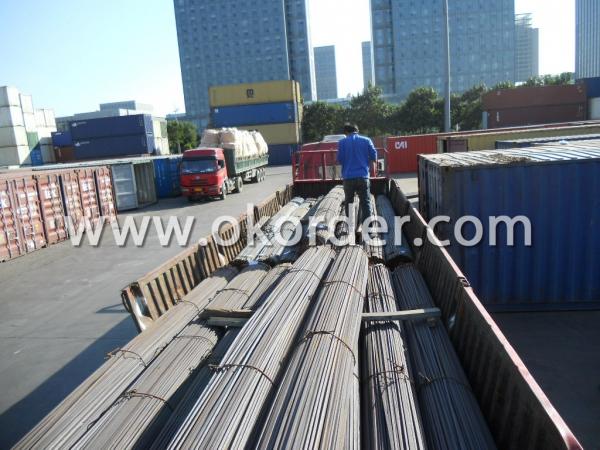
We sincerely welcome partners around the world to establish business cooperation with us on the basis of mutual trust, benefit and development.
- Q: How do you clean and maintain a steel square?
- To clean and maintain a steel square, you will need a few basic supplies and follow a simple process. Here are the steps you can follow: 1. Gather the supplies: You will need a clean cloth or rag, a mild detergent or dish soap, a soft-bristle brush, and water. 2. Start by removing any loose dirt or debris from the steel square. You can use a soft-bristle brush or a cloth to gently brush off any surface dust or dirt. 3. Mix a small amount of mild detergent or dish soap with warm water in a bucket or sink. Make sure to use a gentle soap that won't damage the steel square. 4. Dip the cloth or rag into the soapy water and wring out any excess liquid. Gently wipe the steel square with the damp cloth, making sure to cover all surfaces. 5. If there are any stubborn stains or marks on the steel square, you can use the soft-bristle brush to scrub them gently. Be careful not to apply too much pressure or use abrasive cleaning tools that can scratch the steel surface. 6. Rinse the steel square thoroughly with clean water to remove any soap residue. Ensure that all the soap is completely washed off. 7. Dry the steel square with a clean cloth or towel. Make sure to remove all moisture to prevent any water spots or rust formation. You can also leave it in a well-ventilated area to air dry completely. 8. Once the steel square is dry, you can apply a light coat of rust-resistant oil or silicone spray to protect it from corrosion. Use a clean cloth or rag to apply the oil or spray it directly onto the steel square, following the product instructions. 9. Store the steel square in a dry and clean area to prevent any moisture build-up or further corrosion. Consider using a protective case or wrapping it in a cloth to avoid damage or scratches. By following these steps, you can effectively clean and maintain your steel square, ensuring its longevity and optimal performance.
- Q: What are the different markings on a steel square used for?
- A steel square, also known as a framing square or carpenter's square, is an essential tool used in woodworking, construction, and other trades. It comprises two steel arms that meet at a 90-degree angle. These arms are engraved with different measurements and markings, each serving a specific purpose. 1. Degree Scale: One of the most noticeable markings on a steel square is the degree scale, enabling users to measure and mark angles other than 90 degrees. This scale proves valuable for tasks like cutting rafters, stair stringers, or other angled cuts. 2. Inch Scale: The inch scale, marked along one or both arms, allows for precise measurements in inches. This feature proves handy for measuring and marking lengths or widths of materials. 3. Rafter Tables: Some steel squares have rafter tables printed on one arm, providing measurements and angles for common rafter cuts, hip and valley rafter cuts, and other roofing-related calculations. Carpenters and roofers utilize these tables to determine the correct angles and lengths of rafters needed for a specific roof design. 4. Octagon Scale: Certain steel squares possess an octagon scale, facilitating the marking out of octagonal shapes. This scale provides the necessary angles and lengths required to construct an octagon, making it useful for projects such as building gazebos or other eight-sided structures. 5. Protractor: Many steel squares incorporate a protractor or angle finder into one arm. This enables users to accurately measure and mark angles, especially when attempting to replicate or transfer an existing angle. 6. Center Finding Scale: Several steel squares feature a center finding scale that assists users in locating the center point of a board or material. This scale proves beneficial for tasks like drilling holes or marking the midpoint for symmetrical cuts. In conclusion, the different markings on a steel square enhance its versatility and functionality. They enable users to measure angles accurately, mark dimensions precisely, and perform various calculations. As a result, the steel square becomes an indispensable tool for carpenters, woodworkers, and construction professionals.
- Q: How do you use a steel square to determine the angle of a cove cut?
- To determine the angle of a cove cut using a steel square, proceed as follows: 1. Begin by placing the steel square on the surface where the cove cut will be made. Ensure that one side of the square is aligned with the edge of the material. 2. Align the other side of the square with the desired angle for the cove cut. Set the angle according to the design or specifications being followed. 3. Once the square is properly aligned, use a pencil or marking tool to mark the angle on the material's surface. 4. Use an appropriate cutting tool, such as a jigsaw, bandsaw, or router, to cut along the marked angle. Make sure to have safety measures in place and follow the manufacturer's instructions for your specific cutting tool. 5. Cut slowly and carefully, closely following the marked angle. Take your time to achieve a precise and accurate cove cut. Always exercise caution and wear proper safety gear when operating power tools or cutting materials. It is also advisable to double-check measurements and angles before making the cut to ensure accuracy and achieve the desired results.
- Q: How do you use a steel square to measure and mark 22.5-degree angles?
- In order to measure and mark a 22.5-degree angle using a steel square, several simple steps must be taken. Begin by positioning the steel square so that the long edge (hypotenuse) faces you, while the shorter edge (leg) is on the left side. It is important to ensure that the right angle formed by these two edges is placed at the starting point of the desired angle. Next, locate the scale on the leg of the square. This scale typically represents degrees, so locate the 45-degree mark on the scale, which is positioned halfway between 0 and 90 degrees. Starting from the 45-degree mark, count two units to the right. Each unit on the scale represents one degree, so by counting two units, we obtain 2 degrees. This is due to the fact that a 45-degree angle lies halfway between 0 and 90 degrees, and half of 45 equals 22.5. Once the 2-degree mark has been identified, use a pencil to draw a line along the edge of the square that intersects this mark. This line will serve as a representation of a 22.5-degree angle. To verify the accuracy of the measurement, it is also possible to measure the angle using a protractor. Place the protractor at the starting point of the angle and align its baseline with the line drawn using the steel square. Confirm that the protractor's zero-degree line aligns with the line from the square, and then check that the protractor indicates an angle of 22.5 degrees. By adhering to these instructions, it is possible to precisely measure and mark a 22.5-degree angle using a steel square.
- Q: How do you use a steel square to find the center of a square?
- To accurately locate the center of a square, one can utilize a steel square by following these instructions: 1. Begin by positioning the steel square on one side of the square, ensuring that one of its edges aligns with the side of the square. 2. Proceed to extend the edge of the steel square across the square, resulting in a mark being made on the opposite side of the square. 3. Subsequently, replicate the previous step on the adjacent side of the square, generating another mark on the opposite side. 4. The point of intersection between the two marks signifies the center of the square. To validate this, a line can be drawn connecting this point with the diagonally opposite corners of the square. By employing a steel square in this manner, one can effortlessly and accurately determine the center of a square.
- Q: How do you use a steel square for marking roof valley rafter angles?
- To use a steel square for marking roof valley rafter angles, start by placing the square against the edge of the rafter board and aligning it with the desired angle. Then, mark the angle along the edge of the square onto the rafter board. Repeat this process for each rafter, ensuring accurate and consistent markings for a precise roof valley.
- Q: What are the common uses of a steel square in welding?
- A steel square is commonly used in welding for measuring and marking angles, ensuring accurate and precise cuts, and checking the alignment of welded joints. It is also used for laying out or squaring parts before welding, verifying perpendicularity, and determining the squareness of corners.
- Q: How do you use a steel square to determine the slope of a garden fence?
- To determine the slope of a garden fence using a steel square, you would first place one edge of the square against the ground at the base of the fence post. Then, align the other edge of the square with the fence post, ensuring it remains vertical. By checking the level on the steel square, you can determine if the fence post is leaning or if it is straight. This will help you assess the slope of the garden fence.
- Q: How do you use a steel square to find angles for compound coping cuts?
- To use a steel square to find angles for compound coping cuts, you can follow these steps: 1. Place the steel square on the material you want to cut, aligning one edge of the square with the straight edge of the material. 2. Adjust the square to the desired angle by rotating it until the desired angle is achieved. The steel square will have different angles marked on it for reference. 3. Once you have set the steel square to the desired angle, use a pencil or marker to mark the line on the material along the edge of the square. 4. Repeat the process for any other angles needed for the compound coping cut, ensuring the steel square is properly aligned and marked. 5. Connect the marked lines to form the shape of the compound coping cut, and use appropriate tools such as a coping saw to carefully cut along the marked lines. By using a steel square, you can accurately measure and mark angles for compound coping cuts, making the cutting process more precise and efficient.
- Q: Can a steel square be used for checking the alignment of a door frame?
- Yes, a steel square can be used for checking the alignment of a door frame. It can be used to ensure that the corners of the door frame are square and that the sides are perpendicular.
1. Manufacturer Overview
| Location | Renqiu, China |
| Year Established | 1996 |
| Annual Output Value | Above US$ 30 Million |
| Main Markets | Mid East; Southeast Aisa |
| Company Certifications |
2. Manufacturer Certificates
| a) Certification Name | |
| Range | |
| Reference | |
| Validity Period |
3. Manufacturer Capability
| a) Trade Capacity | |
| Nearest Port | Tianjin; |
| Export Percentage | 20% - 30% |
| No.of Employees in Trade Department | 11-20 People |
| Language Spoken: | English; Chinese |
| b) Factory Information | |
| Factory Size: | Above 70,000 square meters |
| No. of Production Lines | 1 |
| Contract Manufacturing | OEM Service Offered |
| Product Price Range | Average |
Send your message to us
Hot Rolled Square Bar
- Loading Port:
- Tianjin Port
- Payment Terms:
- TT or LC
- Min Order Qty:
- 50Tons m.t.
- Supply Capability:
- 500 tons per month m.t./month
OKorder Service Pledge
OKorder Financial Service
Similar products
Hot products
Hot Searches
Related keywords
